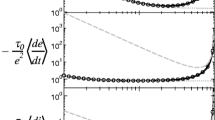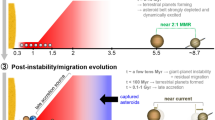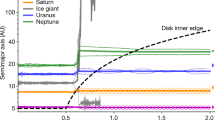Abstract
We present the results of an extensive study of the final stage of terrestrial planet formation in disks with different surface density profiles and for different orbital configurations of Jupiter and Saturn. We carried out simulations in the context of the classical model with disk surface densities proportional to \({r^{-0.5}}, {r^{-1}}\) and \({r^{-1.5}}\), and also using partially depleted, non-uniform disks as in the recent model of Mars formation by Izidoro et al. (Astrophys J 782:31, 2014). The purpose of our study is to determine how the final assembly of planets and their physical properties are affected by the total mass of the disk and its radial profile. Because as a result of the interactions of giant planets with the protoplanetary disk, secular resonances will also play important roles in the orbital assembly and properties of the final terrestrial planets, we will study the effect of these resonances as well. In that respect, we divide this study into two parts. When using a partially depleted disk (Part 1), we are particularly interested in examining the effect of secular resonances on the formation of Mars and orbital stability of terrestrial planets. When using the disk in the classical model (Part 2), our goal is to determine trends that may exist between the disk surface density profile and the final properties of terrestrial planets. In the context of the depleted disk model, results of our study show that in general, the \(\nu _5\) resonance does not have a significant effect on the dynamics of planetesimals and planetary embryos, and the final orbits of terrestrial planets. However, \(\nu _6\) and \(\nu _{16}\) resonances play important roles in clearing their affecting areas. While these resonances do not alter the orbits of Mars and other terrestrial planets, they strongly deplete the region of the asteroid belt ensuring that no additional mass will be scattered into the accretion zone of Mars so that it can maintain its mass and orbital stability. In the context of the classical model, the effects of these resonances are stronger in disks with less steep surface density profiles. Our results indicate that when considering the classical model (Part 2), the final planetary systems do not seem to show a trend between the disk surface density profile and the mean number of the final planets, their masses, time of formation, and distances to the central star. Some small correlations were observed where, for instance, in disks with steeper surface density profiles, the final planets were drier, or their water contents decreased when Saturn was added to the simulations. However, in general, the final orbital and physical properties of terrestrial planets seem to vary from one system to another and depend on the mass of the disk, the spatial distribution of protoplanetary bodies (i.e., disk surface density profile), and the initial orbital configuration of giant planets. We present results of our simulations and discuss their implications for the formation of Mars and other terrestrial planets, as well as the physical properties of these objects such as their masses and water contents.














Similar content being viewed by others
Notes
Because in the Nice model, Jupiter and Saturn are initially in circular orbits, \(\nu _6\) does not manifest itself clearly. In order to make this resonance show, we slightly increased the eccentricities of the two giant planets to 0.01. This is consistent with the initial orbital eccentricities of these planets in the Nice model-II (Levison et al. 2011).
In all our numerical integrations throughout this study, we determine the locations of secular resonances by monitoring the precession rates of protoplanetary bodies and planetesimals, and comparing them with those of Jupiter and Saturn. Secular resonances increase the orbital eccentricities and inclinations of their affected bodies. We also monitor these quantities and mark the time and semimajor axis at which eccentricity and inclination are maximally enhanced.
According to the calculations by Nagasawa et al. (2005), the outward displacement of \(\nu _6\) in our disk models should be no more than 0.1 AU. This outward displacement would be smaller in disks with less steep surface density profiles (i.e., lower values of \(\alpha \)). While in our simulations, the \(\nu _6\) resonance did move outward, the amount of its displacement was slightly larger than that suggested by Nagasawa et al. (2005). For example, in a disk with \(\alpha =1.5\) and considering Jupiter and Saturn in their current orbits, \(\nu _6\) appeared around 2.35 AU, which corresponds to an outward displacement of 0.2–0.3 AU compared to the location of this resonance in simulations considering test particles and same configuration for giant planets. Our results indicate that the calculations by Nagasawa et al. (2005) underestimates the outward sweeping of secular resonances by not considering the disk gravitational potential.
References
Agnor, C.B., Canup, R.M., Levison, H.F.: On the character and consequences of large impacts in the late stage of terrestrial planet formation. Icarus 142, 219–237 (1999)
Agnor, C.B., Lin, D.N.C.: On the migration of Jupiter and Saturn: constraints from linear models of secular resonant coupling with the terrestrial planets. ApJ 745, 143 (2012)
Brasser, R., Walsh, K.J., Nesvorný, D.: Constraining the primordial orbits of the terrestrial planets. Mon. Not. R. Astron. Soc. 433, 3417–3427 (2013)
Bottke, W.F., Nesvorný, D., Grimm, R.E., Morbidelli, A., O’Brien, D.P.: Iron meteorites as remnants of planetesimals formed in the terrestrial planet region. Nature 439, 821–824 (2006)
Chambers, J.E., Wetherill, G.W.: Making the terrestrial planets: N-body integrations of planetary embryos in three dimensions. Icarus 136, 304–327 (1998)
Chambers, J.E.: A hybrid symplectic integrator that permits close encounters between massive bodies. MNRAS 304, 793–799 (1999)
Chambers, J.E.: Making more terrestrial planets. Icarus 152, 205–224 (2001)
Chambers, J.E., Cassen, P.: The effect of surface density profile and giant planet eccentricities on planetary accretion in the inner solar system. MAPS 37, 1523–1540 (2002)
Chambers, J.E.: Forming terrestrial planets. Science 344, 479–480 (2014)
Dauphas, N., Pourmand, A.: Hf-W-Th evidence for rapid growth of Mars and its status as a planetary embryo. Nature 473, 489–492 (2011)
Gomes, R.S., Levison, H.F., Tsiganis, K., Morbidelli, A.: Origin of the cataclysmic late heavy bombardment period of the terrestrial planets. Nature 435, 466–469 (2005)
Haghighipour, N., Scott, E.R.D.: Meteorite constraints on the early stages of planetary growth in the inner solar system. Lunar Planet. Sci. 39, 1679 (2008)
Haghighipour, N., Scott, E.R.D.: On the effect of giant planets on the scattering of parent bodies of iron meteorite from the terrestrial planet region into the asteroid belt: a concept study. ApJ 749, 113 (2012)
Hansen, B.M.S.: Formation of the terrestrial planets from a narrow annulus. ApJ 703, 1131 (2009)
Izidoro, A., Torres, K.S., Winter, O.C., Haghighipour, N.: A compound model for the origin of Earth’s water. ApJ 767, 54 (2013)
Izidoro, A., Haghighipour, N., Winter, O.C., Tsuchida, M.: Terrestrial planet formation in a protoplanetary disk with a local mass depletion: a successful scenario for the formation of mars. ApJ 782, 31 (2014)
Izidoro, A., Raymond, S.N., Morbidelli, A., Winter, O.C.: Terrestrial planet formation constrained by Mars and the structure of the asteroid belt. MNRAS 453, 3620 (2015)
Izidoro, A., Haghighipour, N., Gomes, R.S., Winter, O.C.: Simulating terrestrial planet formation using mercury integrator: a bug report. (in prep.) (2016)
Kaib, N.A., Cowan, N.B.: The feeding zones of terrestrial planets and insight into Moon formation. Icarus 252, 161–174 (2015)
Kaib, N.A., Chambers, J.E.: The fragility of the terrestrial planets during a giant planet instability. MNRAS (2015) (in press) arXiv:1510.08448
Kokubo, E., Ida, S.: Oligarchic growth of protoplanets. Icarus 131, 171–178 (1998)
Kokubo, E., Ida, S.: Formation of protoplanets from planetesimals in the solar nebula. Icarus 143, 15–27 (2000)
Levison, H.F., Agnor, C.: The role of giant planets in terrestrial planet formation. AJ 125, 2692–2713 (2003)
Levison, H.F., Morbidelli, A., Tsiganis, K., Nesvorný, D., Gomes, R.: Late orbital instabilities in the outer planets induced by interaction with a self-gravitating planetesimal disk. ApJ 142, 152 (2011)
Lykawka, P.S., Ito, T.: Terrestrial planet formation during the migration and resonance crossing of giant planets. ApJ 773, 65 (2013)
Malhotra, R.: A few points on the dynamical evolution of the young solar system. In AAS/DDA meeting #45, #400.01 (2014)
Milani, A., Knez̆nević, Z.: Secular perturbation theory and computation of asteroid proper elements. CeMDA. 49, 347–411 (1990)
Minton, D.A., Malhotra, R.: A record of planet migration in the main asteroid belt. Nature 457, 1109–1111 (2009)
Minton, D.A., Malhotra, R.: Secular resonance sweeping of the main asteroid belt during planet migration. ApJ. 732, article id.53 (2011)
Morbidelli, A., Henrard, J.: Secular resonances in the asteroid belt—theoretical perturbation approach and the problem of their location. CeMDA 51, 131–167 (1991a)
Morbidelli, A., Henrard, J.: The main secular resonances nu6, nu5 and nu16 in the asteroid belt. CeMDA 51, 169–197 (1991b)
Morbidelli, A., Lavison, H.F., Tsiganis, K., Gomes, R.S.: Chaotic capture of Jupiter’s Trojan asteroids in the early solar system. Nature 435, 462–465 (2005)
Morbidelli, A., Brasser, R., Tsiganis, K., Gomes, R., Levison, H.F.: Constructing the secular architecture of the solar system-I. The giant planets. Astron. Astrophys. 507, 1041–1052 (2009)
Morbidelli, A., Brasser, R., Gomes, R., Levison, H.F., Tsiganis, K.: Evidence from the Asteroid Belt for a Violent Past Evolution of Jupiter’s Orbit. Astron. J. 140, 1391–1401 (2010)
Morishima, R., Schmidt, M.W., Stadel, J., Moore, B.: Formation and accretion history of terrestrial planets from runaway growth through to late time: implications for orbital eccentricity. ApJ 685, 1247–1261 (2008)
Nagasawa, M., Tanaka, H., Ida, S.: Orbital evolution of asteroids during depletion of the solar nebula. ApJ 119, 1480–1497 (2000)
Nagasawa, M., Ida, S., Tanaka, H.: Excitation of orbital inclinations of asteroids during depletion of a protoplanetary disk: dependence on the disk configuration. Icarus 159, 322–327 (2002)
Nagasawa, M., Lin, D.N.C., Thommes, E.: Dynamical shake-up of planetary systems. I. Embryo trapping and induced collisions by the sweeping secular resonance and embryo-disk tidal interaction. ApJ 635, 578–598 (2005)
Nesvorný, D., Morbidelli, A.: Three-body mean motion resonances and chaotic structure of the asteroid belt. AJ 116, 3029–3037 (1998)
Nimmo, E., Kleine, T.: How rapidly did Mars accrete? Uncertainties in the Hf-W timing of core formation. Icarus 191, 497–504 (2007)
O’Brien, D.P., Morbidelli, A., Levison, H.F.: Terrestrial planet formation with strong dynamical friction. Icarus 184, 39–58 (2006)
Quintana, E.V., Lissauer, J.J.: The effect of planets beyond the ice line on the accretion of volatiles by habitable-zone rocky planets. ApJ 786, 33 (2014)
Raymond, S.N., Quinn, T., Lunine, J.I.: Making other earths: dynamical simulations of terrestrial planet formation and water delivery. Icarus 168, 1–17 (2004)
Raymond, S.N., Quinn, T., Lunine, J.I.: The formation and habitability of terrestrial planets in the presence of close-in giant planets. Icarus 177, 256–263 (2005a)
Raymond, S.N., Quinn, T., Lunine, J.I.: Terrestrial planet formation in disks with varying surface density profiles. ApJ 632, 670–676 (2005b)
Raymond, S.N., Quinn, T., Lunine, J.I.: High resolution simulations of the final assembly of earth-like planets 1: terrestrial accretion and dynamics. Icarus 183, 265–282 (2006)
Raymond, S.N., Quinn, T., Lunine, J.I.: High resolution simulations of the final assembly of earth-like planets 2: water delivery and planetary habitability. Astrobiol. J. 7, 66–84 (2007)
Raymond, S.N., O’Brien, D.P., Morbidelli, A., Kaib, N.A.: Building the terrestrial planets: constrained accretion in the inner solar system. Icarus 203, 644–662 (2009)
Tsiganis, K., Gomes, R.S., Morbidelli, A., Lavison, H.F.: Origin of the architecture of the giant planets of the solar system. Nature 435, 459–461 (2005)
Walsh, K.J., Morbidelli, A., Raymond, S.N., O’Brien, D.P., Mandell, A.M.: A low mass for Mars from Jupiter’s early gas-driven migration. Nature 475, 206–209 (2011)
Ward, W.R.: Solar nebula dispersal and the stability of planetary systems I. Scanning secular resonance theory. Icarus 47, 234–264 (1981)
Wetherill, G.W.: Comparison of analytical and physical modeling of planetesimal accumulation. Icarus 88, 336–354 (1990a)
Wetherill, G.W.: Formation of Earth. AREPS 18, 205–256 (1990b)
Wetherill, G.W.: Provenance of the terrestrial planets. Geochim. Cosmochim. Acta 58, 4513–4520 (1994)
Wetherill, G.W.: The formation and habitability of extra-solar planets. Icarus 119, 219–238 (1996)
Wetherill, G.W.: Contemplation of things past. AREPS 26, 1–22 (1998)
Acknowledgments
We are indebted to A. Izidoro for his help with making the figures and analysis of the results, and for his invaluable comments that greatly improved our manuscript. We are also thankful to the referees for their constructive suggestions and recommendations. NH acknowledges support from the NASA ADAP Program under Grant NNX13AF20G, NASA PAST Program under Grant NNX14AJ38G, HST Grant HST-GO-12548.06-A, and NASA Astrobiology Institute under Cooperative Agreement NNA09DA77A at the Institute for Astronomy, University of Hawaii. OCW acknowledges support from FAPESP (PROC. 2011/08171-3) and CNPq (Proc. 312813/2013-9). Support for program HST-GO-12548.06-A was provided by NASA through a grant from the Space Telescope Science Institute, which is operated by the Association of Universities for Research in Astronomy Incorporated, under NASA Grant NAS5-26555. NH would also like to thank the Alexander von Humboldt Foundation, and the Kavli Institute for Theoretical Physics at the University of California-Santa Barbara (KITP) for their kind hospitality during the final stage of this project. KITP visiting program is supported in part by the National Science Foundation under Grant No. NSF PHY11-25915.
Author information
Authors and Affiliations
Corresponding author
Electronic supplementary material
Below is the link to the electronic supplementary material.
Rights and permissions
About this article
Cite this article
Haghighipour, N., Winter, O.C. Formation of terrestrial planets in disks with different surface density profiles. Celest Mech Dyn Astr 124, 235–268 (2016). https://doi.org/10.1007/s10569-015-9663-y
Received:
Revised:
Accepted:
Published:
Issue Date:
DOI: https://doi.org/10.1007/s10569-015-9663-y




